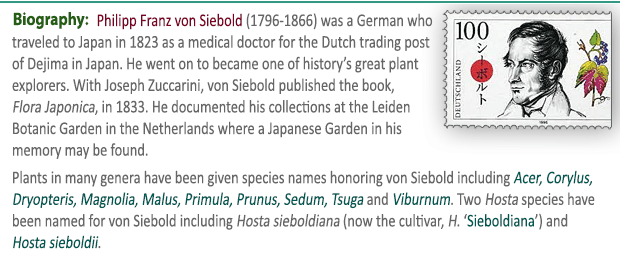
 This is one of the classic hostas
that was originated in 1952 as a hybrid of
H. plantaginea
× H.
lanceolata (According to
The Hostapedia by
Mark Zilis (2009), "probably
H. sieboldii). The cultivar was
registered by
The American Hosta Society on behalf of the originator, Connecticut nurseryman,
Alex Cumming, in 1986. This is one of the classic hostas
that was originated in 1952 as a hybrid of
H. plantaginea
× H.
lanceolata (According to
The Hostapedia by
Mark Zilis (2009), "probably
H. sieboldii). The cultivar was
registered by
The American Hosta Society on behalf of the originator, Connecticut nurseryman,
Alex Cumming, in 1986.

This fast growing large size (24 inches high) mound has wavy,
smooth textured foliage. The leaves are oblong-elliptic and have
average substance. It has fragrant flowers in mid-August and
September.
According to
The Hostapedia by
Mark Zilis (2009),
this cultivar "...ranks as the first hosta
hybrid developed and introduced for sale in the United States.
It is still considered a good landscaping plant due to its fast
growth rate and nicely fragrant flowers."
This cultivar has been awarded the Royal Horticultural Society's
Award of Garden Merit in the
UK.
The New Encyclopedia of Hostas by
Diana
Grenfell (2009) states: "Tolerates full sun, which brings out the elusive
fragrance of the flowers. Flowers open as the temperature rises,
but the leaves turn a sickly green unless they receive plenty of
water. Now superseded as a garden specimen and mainly used for
landscaping."
This plant may have been sold at one time as Mackwoods No. 25.

There was a sibling i.e. from the same seed pod, plant which, to
our knowledge was never given a true cultivar name. It was known
as "FRW No. 829".

 According to
The Hosta Journal, (2000 Vol. 31, No. 1) "H. 'Honeybells' -
first hosta hybrid developed and introduced for sale in the
United States." According to
The Hosta Journal, (2000 Vol. 31, No. 1) "H. 'Honeybells' -
first hosta hybrid developed and introduced for sale in the
United States."
In an article in
The
Hosta Journal (2016 Vol. 47 No 2), the author
described this plant's flowers as having a "Strong" fragrance
compared to other hostas.






|



